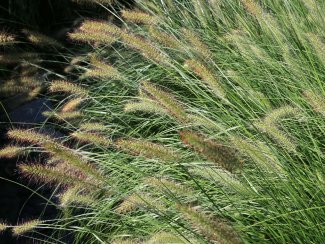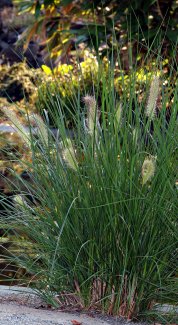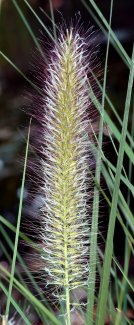Asia: China - Anhui, - Zhejiang, - Fujian, - Heilongjiang, - Henan, - Hebei, - Hubei, - Jiangxi, - Jiangsu, - Guangdong, - Guizhou, - Shandong, - Shaanxi, - Sichuan, - Yunnan, - Xizang, - Hainan; Japan; Korea; Taiwan; India - Assam; Myanmar; Indonesia; Malaysia; Philippines
Australia: Tasmania, New South Wales, Queensland, Victoria
Culms are erect, and 60–100 cm long; leaf-blades are erect or drooping; flat, or conduplicate, or involute; and from 10–45 cm long by 3–6 mm wide.
HABIT Perennial; caespitose. Rootstock evident. Basal innovations intravaginal. Culms erect; 60–100 cm long. Culm-internodes smooth, or scaberulous. Culm-nodes glabrous. Leaves mostly basal. Leaf-sheaths keeled; glabrous on surface. Ligule a fringe of hairs; 0.5–0.75 mm long. Leaf-blades erect, or drooping; flat, or conduplicate, or involute; 10–45 cm long; 3–6 mm wide. Leaf-blade apex attenuate.
INFLORESCENCE Inflorescence a panicle. Peduncle hirsute above. Panicle spiciform; linear; 7–20 cm long; 1–1.5 cm wide. Primary panicle branches accrescent to a central axis; with sessile scars on axis. Panicle axis angular; villous; bearing deciduous spikelet clusters. Spikelets subtended by an involucre. Fertile spikelets sessile; 1–2 in the cluster. Involucre composed of bristles; 15–30 mm long; base bluntly stipitate; base 1–4 mm long; base pubescent. Involucral bristles deciduous with the fertile spikelets; numerous; with an outer whorl of thinner bristles; inner bristles longer than outer; 15–30 mm long; terete; flexible; glabrous, or ciliate.
FERTILE SPIKELETS Spikelets comprising 1 basal sterile florets; 1 fertile florets; without rhachilla extension. Spikelets lanceolate; subterete; 6–8 mm long; falling entire; deciduous with accessory branch structures.
GLUMES Glumes dissimilar; shorter than spikelet; thinner than fertile lemma. Lower glume orbicular; 1–1.25 mm long; 0.15 length of spikelet; hyaline; without keels; 0 -veined. Lower glume lateral veins absent. Lower glume apex obtuse. Upper glume oblong; 0.33–0.5 length of spikelet; membranous; without keels; 5–7 -veined. Upper glume lateral veins obscure. Upper glume apex obtuse, or acute.
FLORETS Basal sterile florets barren; without significant palea. Lemma of lower sterile floret elliptic; 1 length of spikelet; chartaceous; 7 -veined; obtuse, or acute. Fertile lemma lanceolate; 6–8 mm long; chartaceous; without keel; 5–7 -veined. Lemma margins flat. Lemma apex acute. Palea chartaceous. FLOWER Anthers 3; 3.75–4 mm long; anther tip apiculate. Styles free to the base, or connate below.
FRUIT Caryopsis with adherent pericarp; oblong; 2.5–3 mm long. Embryo 0.5 length of caryopsis.
The plant is a warm season ornamental grass which typically grows in graceful, spreading clumps from 2-3' tall and as wide. Features narrow, medium to deep green leaves (to 1/2" wide) in summer, changing to golden yellow in fall and fading to beige in late fall. Foliage usually remains attractive throughout the winter. Showy, silvery to pinkish-white, bristly, bottle brush-like flower spikes arch outward from the clump in late summer like water spraying from a fountain (hence the common name). Flower spikes turn brownish as the seeds form, and spikes usually persist until late fall or early winter before shattering. Many excellent fountain grass cultivars are available in commerce, ranging in height from 1-5' and featuring a variety of different flower colors (purples, pinks or whites) and autumn foliage.


